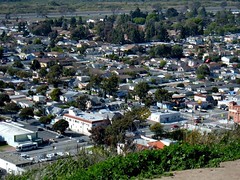Reflections on City Church – A Chain Blog
 Main Claim: Since city church already exists, we must figure out how to recognize and nurture it.
Main Claim: Since city church already exists, we must figure out how to recognize and nurture it.
In every city where Christians are present, a city church already exists as potential reality, waiting to be actualized when enough Christians in that city begin living out the inherent unity of the Church. City church is not waiting on structures or programs, though these are of some value; city church is waiting on knowledge. It is waiting for Christians to recognize that they are members of the one Body. It is waiting for Christians to recognize that, while there are many local churches, there is only one Church and that each local church is an instance of that one Church.
How do we move from potential city church to actual?
It is not enough to rest in a potential City church, for God has not called us to be potential church. He has called us to be his church and getting there requires honesty, confession, and knowledge. We must be honest about our lack of embodiment and confess our unshared stories and unused power.
Now, with all this honesty and confession, let us not be naive and ignore the hurdles. Theology and practice can divide, though it need not be so. We can heal theological disagreements without agreeing on everything (see Healing Theological Disagreements). While it is the case that we ought to agree (for God’s thought is not divided, therefore true theology is not divided), perfect agreement is unlikely this side of direct presence with Jesus. Let us be honest.
Moving from potential to actual also requires knowledge about church and its inherent unity, for knowledge helps us recognize truth when we see it. Some paraphrased gleanings from Earl Radmacher’s What the Church is All About are appropriate here. (See more on this at Unity and Division: Insight from Radmacher.)
- The church is united and thus must be united.
- If either universal or local existence or eternal or temporal authority is overemphasized, then unity and “church-ness” are damaged.
- The church (and therefore unity) is both a spiritual and a physical gathering. If either is emphasized to the exclusion of the other, then unity and “church-ness” are damaged.
- An informed, unrepentant persistence in any imbalance creates a division that must be redeemed and repented of or must be recognized and acted upon.
First, we recognize the truth.
So, if recognition is first, what is it we are to recognize? As mentioned above, we must recognize the inherent unity of the church. This means teaching what the Bible says about church, not merely what tradition and the polity manuals say. Spend time learning to recognize unity; do not spend much time looking at division. Just at bank note fraud investigators learn by studying real money, so we must learn what church should be by studying unity. Then we will know it when we see it.
Recognition also requires being attentive. Pay attention to what God is up to: the Spirit is at work in our cities and we should notice. Pay attention to neglect of unity and attitudes of negativity, and then confront them. Pay attention to patterns of unity that are already present: for example,parachurch organizations working with or serving several local churches.
Of course, recognizing truth in order to move from potential to actual city church, requires that we take actual steps in our cities among our local churches.
Now I must ask, what’s my first step?


You asked, “…what’s my first step?” It seems to me that one first step is to encourage believers in the work world to identify and serve each other in their workplace networks.
Os Hillman has said, “The church in the workplace is the purest form of the body of Christ today due to its diversity.” On the job, Christians form relationships with co-workers, supervisors, subordinates, customers, clients, students, and so on–without regard to denominational differences.
The first step, then, would be to learn to identify the Christ-followers in my workplace network. I should look for them as Jesus instructed, using the fruit test. Step Two would be to let the Spirit of God direct me to find creative ways to serve/encourage/pray for/spur on those other members of Christ’s body in my workplace context.
This alone would not solve all the problems associated with seeking the unity of the church in the city. But I believe it would be a valuable first step.
Larry,
Connecting in the workplace captures a better cross section of the church in the city, encourages following Christ in ordinary life, and helps create a network of neighborhoods (I’ve pondered this before).
Now I’m wondering what type of training needs to take place in the local church to encourage these connections. Hmmm.
Yes, that’s a question I’ve wrestled with for quite a while. Christian Overman (author of GOD’S PLEASURE AT WORK: Bridging the Sacred-Secular Divide) and I are partnering in an effort to communicate to pastors the importance of equipping believers for their workplace roles. We recently presented a workshop for pastors in Beaverton, Oregon, and are studying how best to proceed with reaching many more pastors. The book, GOD AT WORK, by David W. Miller, demonstrates how little interest churches and seminaries have shown in preparing Christians to serve in those places where they spend most of their best hours.